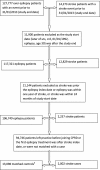Is sodium valproate, an HDAC inhibitor, associated with reduced risk of stroke and myocardial infarction? A nested case-control study
- PMID: 24890032
- PMCID: PMC4312949
- DOI: 10.1002/pds.3651
Is sodium valproate, an HDAC inhibitor, associated with reduced risk of stroke and myocardial infarction? A nested case-control study
Abstract
Background: This study aimed to evaluate whether treatment with sodium valproate (SV) was associated with reduced risk of stroke or myocardial infarction (MI).
Methods: Electronic health records data were extracted from Clinical Practice Research Database for participants ever diagnosed with epilepsy and prescribed antiepileptic drugs. A nested case-control study was implemented with cases diagnosed with incident non-haemorrhagic stroke and controls matched for sex, year of birth, and study start date (ratio of 1:6). A second nested study was implemented with MI as outcome. The main exposure variable was SV therapy assessed as: ever prescribed, pre-stroke year treatment, number of SV prescriptions, and cumulative time on SV drug therapy. Odds ratios were estimated using conditional logistic regression.
Results: Data were analysed for 2002 stroke cases and 13,098 controls. MI analyses included 1153 cases and 7109 controls. Pre-year stroke SV treatment (28%) was associated with increased stroke risk (odds ratio 1.22, 95% confidence interval (CI): 1.09 to 1.38, p < 0.001). No association was observed between ever being prescribed SV with ischemic stroke (OR = 1.01, 95% CI: 0.91 to 1.12, p = 0.875). A significant association was observed between ever being prescribed SV with MI (OR = 0.78, 95% CI: 0.67 to 0.90, p < 0.001). Patients in the highest quarter of SV treatment duration had lower odds of ischemic stroke (OR = 0.57, 95% CI: 0.44 to 0.72, p < 0.001) and MI (OR = 0.29, 95% CI: 0.20 to 0.44, p < 0.001).
Conclusion: Sodium valproate exposure was associated with the risk of MI, but not ischemic stroke. However, longer exposure to SV was associated with lower odds of stroke, but this might be explained by survivor bias.
Keywords: antiepileptic drugs; epilepsy; histone deacetylase (HDAC) inhibitors; ischemic stroke; myocardial infarction; pharmacoepidemiology; sodium valproate.
© 2014 The Authors. Pharmacoepidemiology and Drug Safety published by John Wiley & Sons, Ltd.
Figures

Similar articles
-
Sodium Valproate, a Histone Deacetylase Inhibitor, Is Associated With Reduced Stroke Risk After Previous Ischemic Stroke or Transient Ischemic Attack.Stroke. 2018 Jan;49(1):54-61. doi: 10.1161/STROKEAHA.117.016674. Epub 2017 Dec 15. Stroke. 2018. PMID: 29247141 Free PMC article. Clinical Trial.
-
Psoriasis and risk of incident myocardial infarction, stroke or transient ischaemic attack: an inception cohort study with a nested case-control analysis.Br J Dermatol. 2009 May;160(5):1048-56. doi: 10.1111/j.1365-2133.2008.09020.x. Epub 2009 Feb 4. Br J Dermatol. 2009. PMID: 19210501
-
Degree of serotonin reuptake inhibition of antidepressants and ischemic risk: A cohort study.Neurology. 2019 Sep 3;93(10):e1010-e1020. doi: 10.1212/WNL.0000000000008060. Epub 2019 Aug 7. Neurology. 2019. PMID: 31391245 Free PMC article.
-
Long-Term Risk of Myocardial Infarction Compared to Recurrent Stroke After Transient Ischemic Attack and Ischemic Stroke: Systematic Review and Meta-Analysis.J Am Heart Assoc. 2018 Jan 18;7(2):e007267. doi: 10.1161/JAHA.117.007267. J Am Heart Assoc. 2018. PMID: 29348322 Free PMC article.
-
Increased risk of stroke and myocardial infarction in patients with epilepsy: A systematic review of population-based cohort studies.Epilepsy Behav. 2020 Mar;104(Pt B):106307. doi: 10.1016/j.yebeh.2019.05.005. Epub 2019 Jun 8. Epilepsy Behav. 2020. PMID: 31182394
Cited by
-
Histone Deacetylase (HDAC) Inhibitors - emerging roles in neuronal memory, learning, synaptic plasticity and neural regeneration.Curr Neuropharmacol. 2016;14(1):55-71. doi: 10.2174/1570159x13666151021111609. Curr Neuropharmacol. 2016. PMID: 26487502 Free PMC article. Review.
-
Anti-epileptic Drugs Use and Increased Risk of Stroke: A Systematic Review.Ann Neurosci. 2024 Oct;31(4):283-291. doi: 10.1177/09727531231211685. Epub 2024 Jan 15. Ann Neurosci. 2024. PMID: 39544641 Free PMC article. Review.
-
Valproic Acid Decreases Endothelial Colony Forming Cells Differentiation and Induces Endothelial-to-Mesenchymal Transition-like Process.Stem Cell Rev Rep. 2020 Apr;16(2):357-368. doi: 10.1007/s12015-019-09950-y. Stem Cell Rev Rep. 2020. PMID: 31898801
-
Dual mechanisms for the regulation of brain-derived neurotrophic factor by valproic acid in neural progenitor cells.Korean J Physiol Pharmacol. 2018 Nov;22(6):679-688. doi: 10.4196/kjpp.2018.22.6.679. Epub 2018 Oct 25. Korean J Physiol Pharmacol. 2018. PMID: 30402028 Free PMC article.
-
Mechanisms and treatment of ischaemic stroke--insights from genetic associations.Nat Rev Neurol. 2014 Dec;10(12):723-30. doi: 10.1038/nrneurol.2014.196. Epub 2014 Oct 28. Nat Rev Neurol. 2014. PMID: 25348005 Review.
References
-
- Lv L, Sun Y, Han X, Xu CC, Tang YP, Dong Q. Valproic acid improves outcome after rodent spinal cord injury: potential roles of histone deacetylase inhibition. Brain Res. 2011;1396:60–68. - PubMed
-
- Bowes AJ, Khan MI, Shi Y, Robertson L, Werstuck GH. Valproate attenuates accelerated atherosclerosis in hyperglycemic apoe-deficient mice: evidence in support of a role for endoplasmic reticulum stress and glycogen synthase kinase-3 in lesion development and hepatic steatosis. Am J Pathol. 2009;174:330–342. - PMC - PubMed
Publication types
MeSH terms
Substances
Grants and funding
LinkOut - more resources
Full Text Sources
Other Literature Sources
Medical

